Thursday, 27 June, Koblenz and castles at teatime
Written 7 August 2019
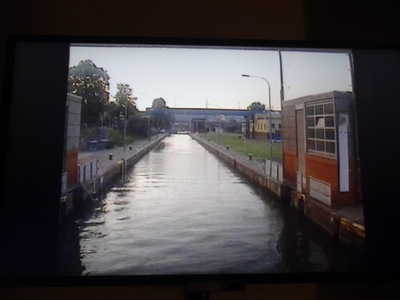
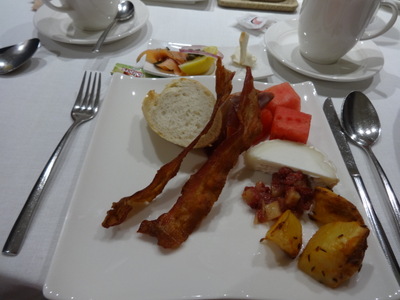 We just stayed in Winningen overnight—David and I never left the ship. At 6 a.m. on Thursday, we cast off again, headed for Koblenz, which is at the confluence of the Moselle and the Rhine. By this time, I had dicovered that another channel on our stateroom TVs continuously showed the view of the bow camera! What a terrific idea. I turned it on Thursday morning as I was getting dressed to go to breakfast and found that we were entering a lock. The photo at the left is taken off the TV screen. We were traveling downstream on the Moselle, so of course we entered each lock high up, then sank to the level of the next stretch of river.
We just stayed in Winningen overnight—David and I never left the ship. At 6 a.m. on Thursday, we cast off again, headed for Koblenz, which is at the confluence of the Moselle and the Rhine. By this time, I had dicovered that another channel on our stateroom TVs continuously showed the view of the bow camera! What a terrific idea. I turned it on Thursday morning as I was getting dressed to go to breakfast and found that we were entering a lock. The photo at the left is taken off the TV screen. We were traveling downstream on the Moselle, so of course we entered each lock high up, then sank to the level of the next stretch of river.
At the right is my breakfast plate. Bread, excellent bacon, ham (under the bacon), some watermelon, a crescent of goat cheese, a dab of corned-beef hash (out of a can, I think; not worth going back for more of), and roasted potatoes. At the top, a little dish of smoked salmon, capers, red onion, and lemon. The odd-shaped little white thing to the right of it is a dab of cream cheese with a token sliver of crisp toast stuck in it. They arranged these little plates almost every morning, and you could take several if you wanted. The patch of green to the left of the salmon is the wrapper of a packet of instant decaf coffee, which I brought with me from home. The best kind of café au lait is instant coffee made with hot milk instead of water. There was no hot milk on the buffet, but the machine at the coffee station just outside the dining room door dispensed it, so I picked up a cup on the way in.
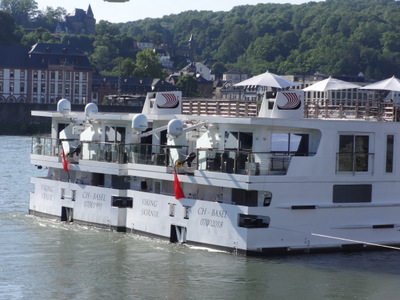
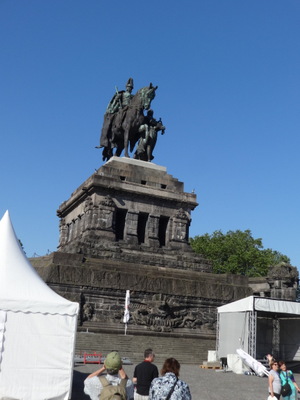 At Koblenz, the Moselle flows into the Rhine at an acute angle. We came down the Moselle, made a sharp turn to the right, cruised upstream on the Rhine for a couple of hundred yards, and moored. Another Viking ship, the Skirnir, was already there, so we moored outboard of it and had to walk through its lobby to disembark. As the lettering on their sterns shows, both are registered in Basel (Switzerland). If the last four digits of their numbers are dates, then the Skirnir is considerably newer.
At Koblenz, the Moselle flows into the Rhine at an acute angle. We came down the Moselle, made a sharp turn to the right, cruised upstream on the Rhine for a couple of hundred yards, and moored. Another Viking ship, the Skirnir, was already there, so we moored outboard of it and had to walk through its lobby to disembark. As the lettering on their sterns shows, both are registered in Basel (Switzerland). If the last four digits of their numbers are dates, then the Skirnir is considerably newer.
On the sharp point between the two rivers (called the "Deutsches Eck," the "German Corner") is this monumental, not to say gargantuan, equestrian statue of Kaiser William I. It was erected in 1897 to commemorate William's role in the unification of Germany. It was destroyed in WWII (the original head is now in a museum), but after German reunification (and many controversial discussions and the help of a wealthy donor) the replica you see here was put up in 1993. William is dressed as a commander of the Prussian army; the angel standing by his left stirrup wears the imperial crown for him.
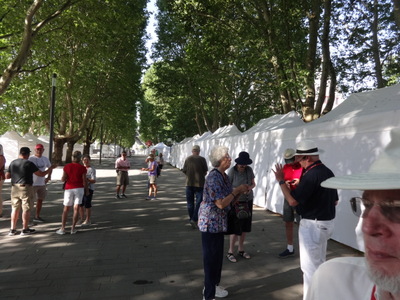
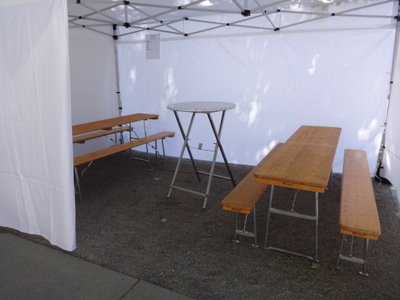 Like the castle in Cochem, Koblenz was thickly encumbered with festival tents. When we came ashore on this riverside walk, I asked if a market were about to open, but no, all the tents that line the walk (and many other areas around town) are a propos of an upcoming footrace.
Like the castle in Cochem, Koblenz was thickly encumbered with festival tents. When we came ashore on this riverside walk, I asked if a market were about to open, but no, all the tents that line the walk (and many other areas around town) are a propos of an upcoming footrace.
The photo at the right shows the interior of one. During our walk, we had to dodge forklifts, as these folding benches and tables were still being installed in the tents, and huge stacks of them were being moved around. Apparently, every company for miles around rents one or more of the tents, brings in a supply of beer, and hosts its employees who aren't running while they cheer on those who are.
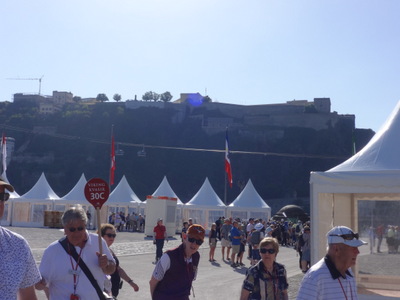
 Across the river, on the top of the bluff is the Ehrenbreitstein Fortress. The site has been fortified since the 9th century, but the fortifications were continually modified and rebuilt for centuries, right up into the 19th century. It's yet another edifice that Louis XIV took, then abandoned and destroyed (in this case, blew up), but it took the French troops five sieges and 10 years to take it. (I'm betting it was Vauban who finally figured out how to beat it.) After WWII it was supposed to be destroyed again, but Henry T. Allen, chief allied commander of this area after the war, countermanded those orders. It now houses several museums and performance venues.
Across the river, on the top of the bluff is the Ehrenbreitstein Fortress. The site has been fortified since the 9th century, but the fortifications were continually modified and rebuilt for centuries, right up into the 19th century. It's yet another edifice that Louis XIV took, then abandoned and destroyed (in this case, blew up), but it took the French troops five sieges and 10 years to take it. (I'm betting it was Vauban who finally figured out how to beat it.) After WWII it was supposed to be destroyed again, but Henry T. Allen, chief allied commander of this area after the war, countermanded those orders. It now houses several museums and performance venues.
As we walked into town, following the guide with the red Viking lollipop you can see in the left-hand photo ("30" means the Kvasir, and we were in group C that day), we were shown these three white slabs, which are actual pieces of the Berlin Wall. The left-hand one is inscribed (I think) "The opening of the wall"; the other two bear dates: 17 June 1953 and 9 November 1989 (presumably the dates between which the wall stood).
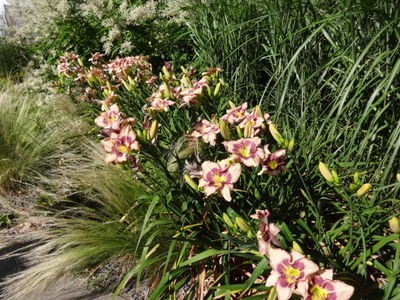
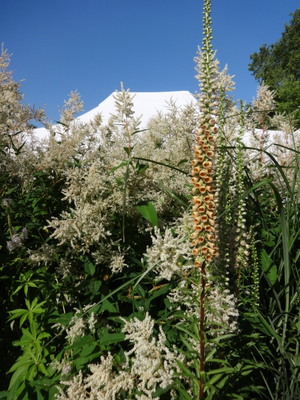 Koblenz had great ornamental plantings. At the left here are short-stalked daylilies, and at the right foxgloves and maybe astilbe?
Koblenz had great ornamental plantings. At the left here are short-stalked daylilies, and at the right foxgloves and maybe astilbe?
I also finally found some sycamores with old fruits still attached and was able to confirm that they are
P. orientalis, with chains of three or more fruit. Here in the U.S., we have P. occidentalis, with just one fruit per stalk. A popular street tree in Europe, especially in Britain, is the London plane, a hybrid of the two species, which has just two fruits per stalk. The hybrid has the advantage of dropping fewer branches on parked cars (a drawback of orientalis for street planting).
p>
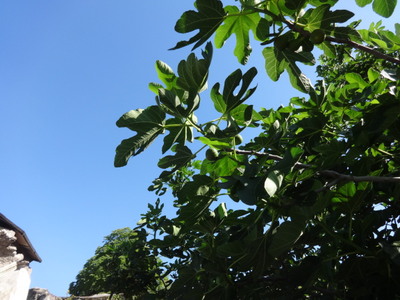
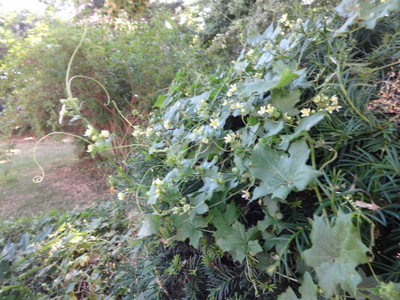 This huge fig tree was on the grounds of the Basilica of St. Kastor. The large figs weren't ripe yet. The wild cucumber at the right probably wasn't supposed to be part of the plantings, but I sort of like wild cucumbers, even as weeds.
This huge fig tree was on the grounds of the Basilica of St. Kastor. The large figs weren't ripe yet. The wild cucumber at the right probably wasn't supposed to be part of the plantings, but I sort of like wild cucumbers, even as weeds.
When, in the late 9th century, Charlemagne's grandsons divided the empire, the process took place here, and this this church marked the the dividing line. It was the seat of a knights' order, similar to the Templars. It was dedicated to St. Kastor in 1180—he was a Roman soldier converted to Christian belief. Up until the 18th century, the church was associated with a monastery, which has since been replaced with a garden (where the fig and cucumber grow among the ruins). According to a plaque over the door, the church has been designated a "minor basilica" by the pope.

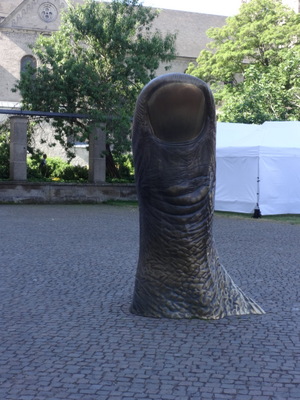 On the way to St. Kastor's, we passed the Ludvig Museum of modern art. Ludvig was a rich industrialist who donated the house and collection.
On the way to St. Kastor's, we passed the Ludvig Museum of modern art. Ludvig was a rich industrialist who donated the house and collection.
On the lawn were this handbag and bottle of Chanel #5 made of sheet metal, and nearby I was delighted to see what I immediately recognized as César's Thumb! It's only a couple of meters tall, though; the exemplar at La Défense in Paris is 12 m high!
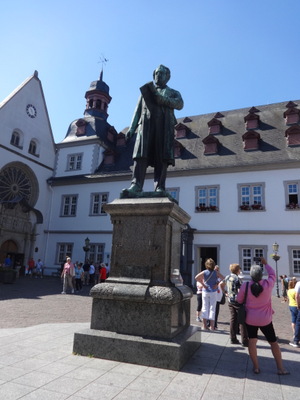
 Here (left) is a statue commemorating Koblenz native Johannes Peter Müller, 19th century physician, physiologist, and natural historian.
Here (left) is a statue commemorating Koblenz native Johannes Peter Müller, 19th century physician, physiologist, and natural historian.
At the right, just come whimsical ducks paved into the sidewalk. Cute.
According to our guide, Koblenz has no Roman buildings left. The Romans stayed until the 5th century, when the Franconians took over. The situation changed in 1000 AD when the archbishops of Trier took over the king's court her. In the 14th century, Baldouin (Baldwin), Archbishop of Trier built the old, stone bridge. The archbishops remained in power until Napoleon conquered the left bank of the Rhine. The French were the first to elect democrat Parliaments.
Although no Roman buildings remain, anytime you build anything in Koblenz, you must allow an extra two or three years for the process. The first dig invariably strikes Roman ruins, which have to be assessed, excavated, approved, etc., so building anything new takes a long time.
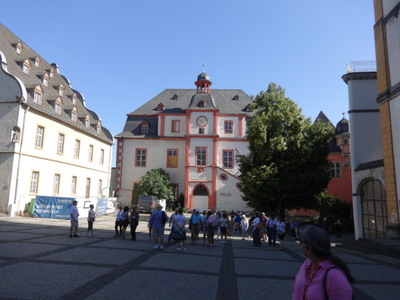
 The guide pointed out many historic buildings as we went. A dark-red house in the middle of town he said had been the home of the groers' guilde. Another was built by a rich and noble family that had produced an Archbishop of Mainz. Both are now privately owned. One church, with an elegant white tower, was dedicated to St. Florin, a major patron saint of wine makers. The French used it as a storehouse and then as a slaughterhouse, but it was eventually given to the local protestants, who continue to use it today.
The guide pointed out many historic buildings as we went. A dark-red house in the middle of town he said had been the home of the groers' guilde. Another was built by a rich and noble family that had produced an Archbishop of Mainz. Both are now privately owned. One church, with an elegant white tower, was dedicated to St. Florin, a major patron saint of wine makers. The French used it as a storehouse and then as a slaughterhouse, but it was eventually given to the local protestants, who continue to use it today.
I think the two-tone yellow and white house on the left wide of this square is the one pointed out to us as having been a synagogue. It started out as a mansion but was purchased by the Jewish community. On 9 November 1939, it was gutted by a pogrom, and abourt half of the town's 500 Jewish residents were deported. During WWII, many Jewish residents were hidden in their neighbors' homes only to be killed by bombing because they couldn't come out to go to bomb shelters. The town current as about 1000 Jewish citizens.
All three buildings around this square are now in private hands and are being renovated, used by the university and for private parties. Below the clock on the one in the middle is an unusual jack. At some point in the town's history, a robber baron was caught and beheaded, but he reportedly rolled his eyes and stuck out his tongue in derision right up until the axe fell. Now, a portrait of him below the clock rolls its eyes and sticks out its tongue on the hour (10 times when we were there at 10 a.m.). I had my binoculars with me, so I trained them on the clock at about 3 minutes before 10. To my surprise, the eyes were already rolling. When I pointed that out to the guide, he was astonished. You can see the bright red tongue from where we stood far below, but he had assumed the eyes had stopped working years ago, never having been able to see them move. Well, they did and were still rolling when we left at 10:10 a.m. Maybe they roll all the time. I think the guide said that the building was the "department store" of Koblenz, dating from ca. 1500. The clock was added later.
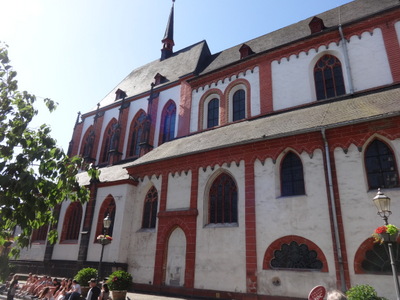
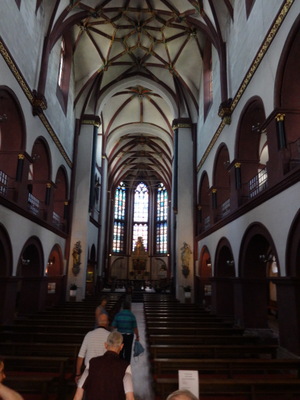 The only church we actually went inside was the Catholic Liebfrauenkirche, shown at the left. At the right is a view down the nave.
The only church we actually went inside was the Catholic Liebfrauenkirche, shown at the left. At the right is a view down the nave.
It dates from the 5th century, and the twin towers on its façade (of which you can only see the pinnacle of one in this shot) incorporate onion domes. Its interior style is Romanesque—note the round arches—though a few experior structures have pointed, Gothic ones.
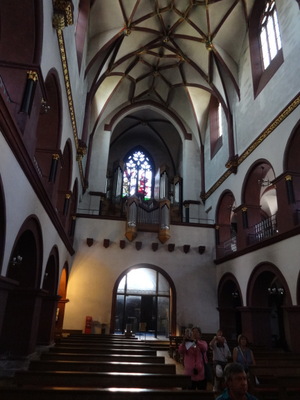
 At the left here is the view back the other way along the nave, showing some of the pipes of the organ.
At the left here is the view back the other way along the nave, showing some of the pipes of the organ.
The stained glass of the apse is from the 1990's; its theme is women in the church. Our particular attention was drawn to the section I show here at the right. If you look closely at the pane nearest the center of the photo, you can see part of a yellow star of David. It commemorates Edith Stein, a German Jewish philosopher who converted to catholcism and became a discalced Carmelite nun; she died at Auschwitz and was canonized in 1989). Hildegard of Bingen is also there somewhere, but I never spotted her.
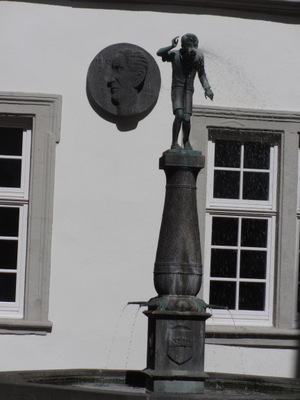
 In a smaller courtyard, the guide showed us this fountain, a famous landmark of Koblenz. After the French occupation of 1794–1814, Koblenz found itself with a whole generation of children born to French fathers and unwed mothers. The mothers had to work, and no father figures were around, so the boys, in particular ran unsupervised and wild. These boys were derisively called "Jean," prototypically French, but it was corrupted to "schang" and than "schängel." The word is still used affectionately today for a small child, meaning something like "brat" or "kid."
In a smaller courtyard, the guide showed us this fountain, a famous landmark of Koblenz. After the French occupation of 1794–1814, Koblenz found itself with a whole generation of children born to French fathers and unwed mothers. The mothers had to work, and no father figures were around, so the boys, in particular ran unsupervised and wild. These boys were derisively called "Jean," prototypically French, but it was corrupted to "schang" and than "schängel." The word is still used affectionately today for a small child, meaning something like "brat" or "kid."
Anyway, they actually became a symbol of Koblenz, and this fountain commemorates them. Most of the time, it stands there not doing anything, but at haphazard intervals, every 30 seconds or so, it abruptly spits water on passers by. We had been warned, and I spotted the wet spot where the water repeatedly landed, so we managed to avoid being spritzed. Around the base, as shown at the right, is a series of reliefs of boys doing mischievous things, like pulling little girls' hair and mocking their elders.
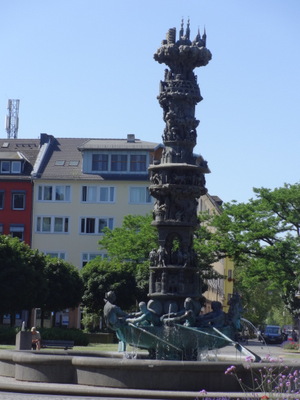
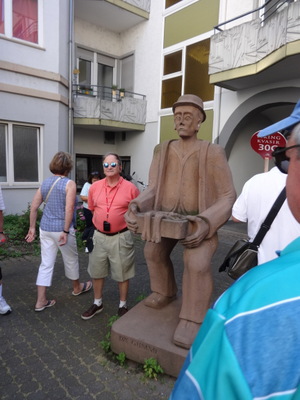 In the square with the rolling eyes and red tongue was this terrific history column. The guide didn't have time to stop and interpret it for us, but its wonderfully intricate and depicts the town's history, from a boat-load of rowers at the bottom to a selection of the town's most recognizable steeples at the top.
In the square with the rolling eyes and red tongue was this terrific history column. The guide didn't have time to stop and interpret it for us, but its wonderfully intricate and depicts the town's history, from a boat-load of rowers at the bottom to a selection of the town's most recognizable steeples at the top.
In a neighborhood that had undergone urban renewal, rustic statues portrayed some of the personalities who had been displaced in the process. This one is Gum, a guy who apparently used to walk the streets selling buttons and suspenders. A block or so away, we saw The Peppermint Lady, who used sell peppermints in the street. After her retirement, she continued walking her old route but giving peppermints away.
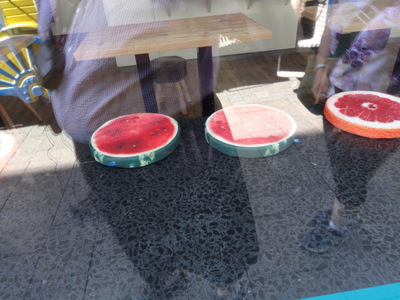
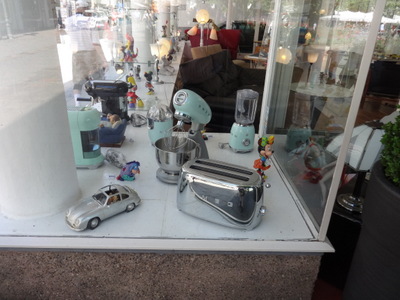 In housewares stores we passed, I spotted these wonderful round cushions, made to depict slices of watermelons and oranges. There were also grapefruit and limes, but they were all the same size as the watermelon slices.
In housewares stores we passed, I spotted these wonderful round cushions, made to depict slices of watermelons and oranges. There were also grapefruit and limes, but they were all the same size as the watermelon slices.
In another window, I couldn't resis that great retro kitchen appliances. I'm not sure whether they were really antiques or modern replicas. I suspect the former.
As we walked from venue to venue, the local guide filled us in on local information:
It was in the 1950s and 60' that the neighborting countries came together to dredge, bank, and manage the Moselle, to maintain the shipping channel and to control flooding.
Last summer, the Rhine had historially low water. All the sand bars came up and played merry havoc with shipping; cargo and container ships. Cruise ships were also stranded, resulting in many disappointed tourists, who hadn't signed up for a cruise only to be hauled everywhere by bus.
Koblenz is in the Rheinland Palatinate, one of 16 federal states of Germany. All have their flags on the Deutsches Eck. The city wall is about 6 meters thick. Reconstructing the old town of Koblenz after WWII took about 40 years and was only finished in 1984.
Napoleon lived in one of the houses we saw (a yellow building with Gothic arches and a chapel, a noble house, 16th century, restored after WWII) when he was in Koblenz (a propos of subduing the left bank of the Rhine.
The city's population is about 113,000. The major local industry is administration; the highest courts for the palatinate are here, and the administration for rivers. The university has 14,000 students, but no faculty of medicine. The university's mainly on the left bank, but some of it is south of town.
Two percent of everyone's salary goes into the equivalent of social security. Every town has senior residences, which tend to be near the center, for easy access to commerce and services. If you're still too poor to pay for a senior residence, even with your saved money, the government subsidizes.
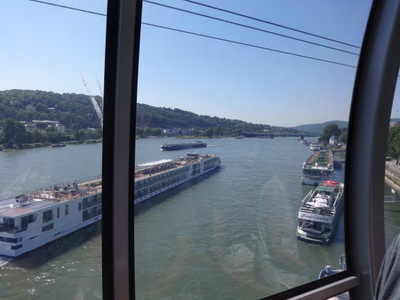
 At the end of the walking tour, our guide took us back to the river bank a ways upstream of the ship and pointed out our mooring to us. David wanted to go back to rest his feet before lunch, but since we arrived, I had been eyeing the magnificent cablecar, whose bottom terminal was just yards from the ship (you can see part of its cable in the photo of the Ehrenbreitstein Fortress, above). I love cablecars; David hates 'em.
At the end of the walking tour, our guide took us back to the river bank a ways upstream of the ship and pointed out our mooring to us. David wanted to go back to rest his feet before lunch, but since we arrived, I had been eyeing the magnificent cablecar, whose bottom terminal was just yards from the ship (you can see part of its cable in the photo of the Ehrenbreitstein Fortress, above). I love cablecars; David hates 'em.
Our path led right by the terminal, so I turned aside to buy a ticket, which David continued on to the mooring. I studied the chart of prices and managed to asked for a single round-trip ticket in a good enough accent that the clerk responded in rapid German, and I had to admit I didn't understand a word. Fortunately, she spoke very good English. Several fellow passengers also bought tickets. The cable runs continuously, so the cars don't actually stop for you to get in; they slow to a snail's pace past the platform, and you just hop aboard. They are completely glass-enclosed.
At the left here is a view (upstream) of the Skirnir departing. At the right (downstream, you can see the Kvasir, having moved aside to let the other ship out, maneuvering to return to the dock, where David was waiting to board.
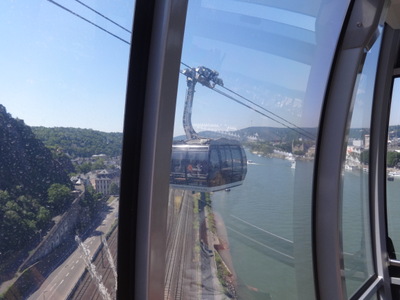
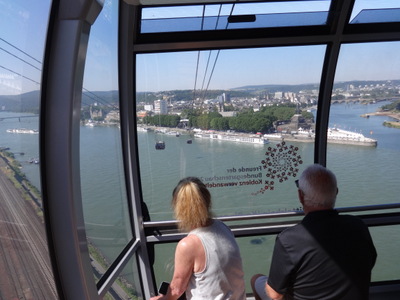 Here are a couple of views from the car, one of a car headed the other way and one looking back toward the town. In the latter, you get a very good view of the Deutsches Eck (with its 16 flags around the edge) and at least the massive pedestal of William I. The statue itself is hard to make out against the dark background.
Here are a couple of views from the car, one of a car headed the other way and one looking back toward the town. In the latter, you get a very good view of the Deutsches Eck (with its 16 flags around the edge) and at least the massive pedestal of William I. The statue itself is hard to make out against the dark background.
In the same photo, you can see both the Kvasir, moored with its nose very near the base of the cable, and the Skirnir, sailing off up the river at the left-hand edge.
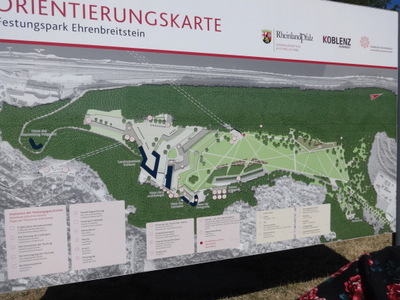
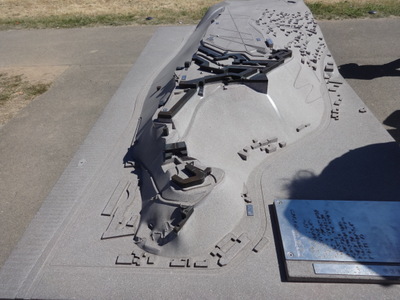 At the top, we were warned to keep our tickets for the return trip. The dotted lines arriving from the top on the green map indicate the cablecar (the ones arriving from the bottom left indicate a funicular, and a road actually seems to come in from the lower right). We therefore found ourselves a good hike from the actual museum buildings, on a vast expanse of open, flat grassland with sidewalks. It was broiling hot up there, and I didn't have a lot of time (we had to be back on board not just for lunch but because at 12:30, the boat was setting sail again), so I just walked around the area near the cablecar terminal photographing this map and the one at the right (a relief map labeled in Braille for the blind), checking out the menu at the snack-bar/coffee shop, reading the posters for upcoming plays and concerts (and a bird-of-prey show), and then got back on the cablecar to go back down. It was the ride I came for, anyway.
At the top, we were warned to keep our tickets for the return trip. The dotted lines arriving from the top on the green map indicate the cablecar (the ones arriving from the bottom left indicate a funicular, and a road actually seems to come in from the lower right). We therefore found ourselves a good hike from the actual museum buildings, on a vast expanse of open, flat grassland with sidewalks. It was broiling hot up there, and I didn't have a lot of time (we had to be back on board not just for lunch but because at 12:30, the boat was setting sail again), so I just walked around the area near the cablecar terminal photographing this map and the one at the right (a relief map labeled in Braille for the blind), checking out the menu at the snack-bar/coffee shop, reading the posters for upcoming plays and concerts (and a bird-of-prey show), and then got back on the cablecar to go back down. It was the ride I came for, anyway.

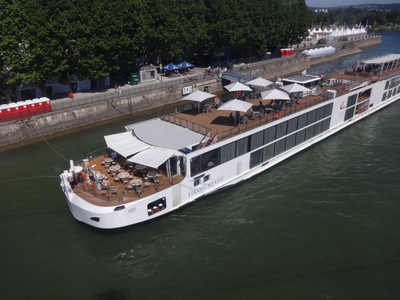 The view at the left here shows the distinctly different colors of the waters of the two rivers where they flow together. The boundary between them persisted for quite a ways downstream.
The view at the left here shows the distinctly different colors of the waters of the two rivers where they flow together. The boundary between them persisted for quite a ways downstream.
At the right, one more view of the bow of the Kvasir, showing the tables on the outdoor terrace forward of the lounge as well as some of the café umbrellas on the sundeck.
After reluctantly disembarking from the cablecar, I continued on to the ship (a matter of a few yards) and was surprised to find David still standing on the shore waiting to board. The captain had had a terrible time remooring at the end of the long gangplank; David says he crashed into it twice before he finally got in position and was still in the process of securing it in place. Only a few minutes after I arrived was the gangplank for boarding. When David told Devin, as he opened the chain to let us through, "That was the worst parking job I've ever seen!," Devin just replied, "Not my department; I'm glad I don't have to do it!"
I was sorry to learn afterward that the cablecar, built in 2011 for a 6-month garden exhibition, only has to run until sometime in the 2020's. After that, it's fate remains unknown.
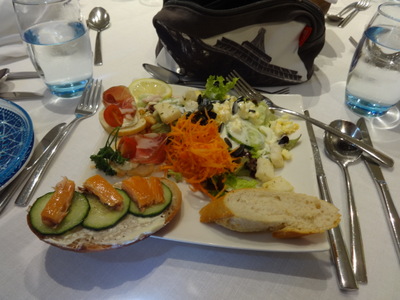
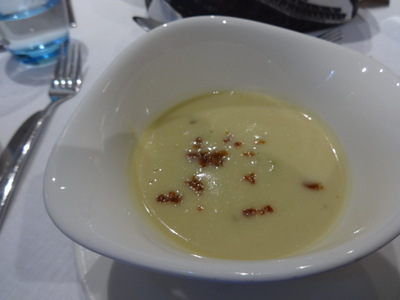 Once again, all the "regional specialties" at lunch were Italian, starting with roasted veggie salad from the salad bar, then coppa and ricotta crostini, and culminating with spaghetti and meatballs from the pasta station.
Once again, all the "regional specialties" at lunch were Italian, starting with roasted veggie salad from the salad bar, then coppa and ricotta crostini, and culminating with spaghetti and meatballs from the pasta station.
I started with a plate from the salad bar (at the left): at the lower left, bread with cucumber slices and hot-smoked (i.e. cooked) salmon (not as good as the cold-smoked they served at breakfast), and at the upper left a couple of the coppa crostinis.
Then I had leek and potato soup with bacon.

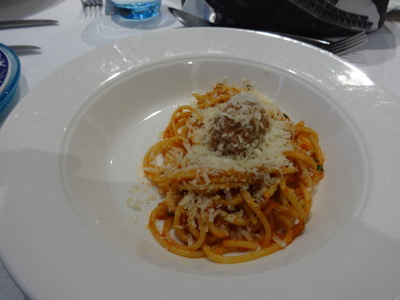 David had the "navarin printanier" (spring stew) of lamb, and I went to the pasta station for just a small portion of the spaghetti and meatballs, which David had had some other day and said was good—he was right.
David had the "navarin printanier" (spring stew) of lamb, and I went to the pasta station for just a small portion of the spaghetti and meatballs, which David had had some other day and said was good—he was right.
The other regular main course choice was an open-faced sandwich of turkey salad with dried cherries on a croissant.
For dessert, I was tempted by the iced coffee float, but decided I didn't want to mess with the caffeine, so I had the vanilla rice pudding. As I expected, given my experience with this chef, it was heavy, stiff, and gummy but palatable enough with the strawberry sauce it came with and the addition of half a fresh passionfruit from the buffet.
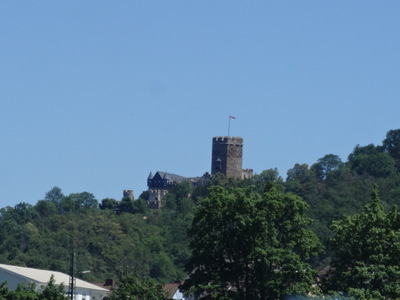
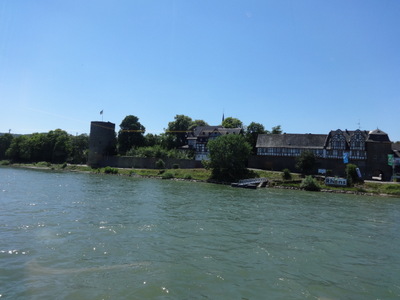 As promised, the ship cast off and headed upstream while we ate lunch, headed for Mainz. Two events were on the agenda. We were passing through the prime ruined-castle country of the middle Rhine, so starting at 2:00 p.m., Devin would narrate, naming the castles and explaining their influence on literature and art. Apparently the whole Romantic movement is the result of tourism in this area. It was popular with vacationers even in the 18th and 19th centuries—Percy Bysse and Mary Shelley were here, and Lord Byron, and all the rest. Mark Twain wrote about it in A Tramp Abroad. Wagner was the court composer of Bavarian but the Song of the Niebelungen/ring cycle was written about the Rhine valley.
As promised, the ship cast off and headed upstream while we ate lunch, headed for Mainz. Two events were on the agenda. We were passing through the prime ruined-castle country of the middle Rhine, so starting at 2:00 p.m., Devin would narrate, naming the castles and explaining their influence on literature and art. Apparently the whole Romantic movement is the result of tourism in this area. It was popular with vacationers even in the 18th and 19th centuries—Percy Bysse and Mary Shelley were here, and Lord Byron, and all the rest. Mark Twain wrote about it in A Tramp Abroad. Wagner was the court composer of Bavarian but the Song of the Niebelungen/ring cycle was written about the Rhine valley.
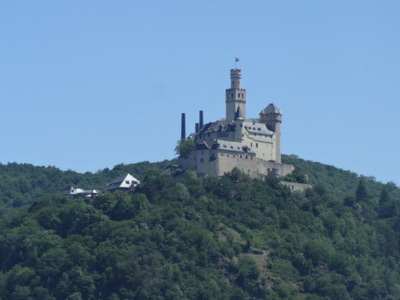
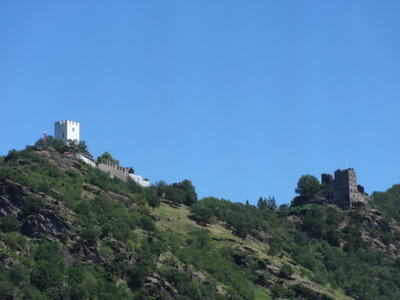 Devin even claimed that a bunch of them were sitting around making up scary stories on one such trip, and when Mary Shelly's turn came she won the competition hands down and stood all their hair on end with the original form of her Frankenstein story.
Devin even claimed that a bunch of them were sitting around making up scary stories on one such trip, and when Mary Shelly's turn came she won the competition hands down and stood all their hair on end with the original form of her Frankenstein story.
So here are half a dozen photos of castles, which I'm afraid I can't match names to. You might be able to sort them out by Googling "castles of the Rhine" and matching images. I'm not going to.
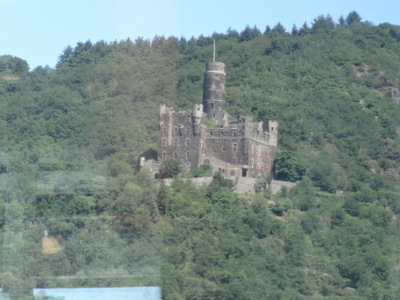
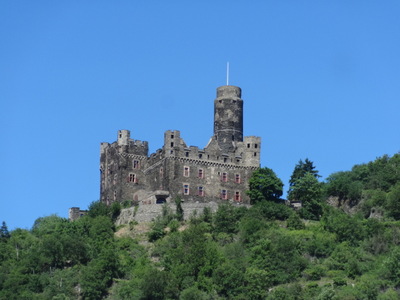 More castles, and I saw some herring gulls over the river. At one point, we passed the Viking Hild headed the other way.
More castles, and I saw some herring gulls over the river. At one point, we passed the Viking Hild headed the other way.
Two of the castles we passed, only a mile or so apart, and maybe called Sternberg and Liebenstein, and maybe known as Mouse Castle and Cat Castle, belonged to enemy brothers. Not clear whether they were enemies over inheritance or over a woman. (My notes say: "Mouse castle, little square dark brown thing with a white flagpole on top of a round tower; reddish windows. Cat castle, with 3-4 round turrets and a square tower surrounding a ruined black taller keep," so I think the one at the right here is Mouse.)
Between castles, Devin lectured on the history of the area. One very old jawbone has been found, but then Cro-Magnan man was here later, then Celtic tribes, then the Helvetians. Then the Romans. Julius Caesar himself was here and, in 35 BC, built the first bridge across the Rhine, to move troops. The Romans had 200 military camps, just along the Rhine. In 1600's the windmill was developed to pump water out of the Netherlands and locals adopted it as a source of power.
After the Romans came the Franconians.
[Pause for apology: No, they can't open the umbrellas on the foredeck, despite the blazing sun, because we're coming to a windy area where they would get blown off into the river.]
In 496 came the first Frankish king, Clovis I (of the Merovingien dynasty). He saw irises in the river and judged that they indicated shallow water and therefore a place where it was safe for his troops to cross. He's the one who adopted the iris as a symbol, which later became the fleur de lis. He also thought the Christian god had helped in his conquests, so he converted to Christianity.
Charlemagne, from the Oder to France to found the Carolingien dynasty. His grandsons split Frankia into three sections (later, two of them would become France and Germany). Charles the Bald got the French part Louis the German one. The third grandson was Lothar.
In 962, Otto I, a Saxon, first of the Ottonian dynasty, brought all the little kingdoms together, united them all and was crowned by the pope as the first Holy Roman Emperor. (I knew it couldn't be as simple as Constantine's conversion . . .)
In the 1100s, the robber barons started taking over castles along the river and charging tolls on a free-lance basis. Then the Hapsburgs set up the Rhine league and destroyed the castles, getting rid of the robber barons.
[The village we passed at this point is just about 10% red burgundy vines and the rest Riesling.]
The 8th to the 16th centuries were pretty calm, but then in 1574 the reformation happened. It was over in 1648, with the end of the 30-years-war betwee the protestants and Catholics, which started in 1618.
Swedes came through in the 1630's; Gustavus Adolphus made it far as Heidelberg.
The prince elector in Heidelberg sent his daughter Liselotte off to France to marry the brother of Louis XIV. Louis XIV tries to take over the Rhineland but is pushed back; he wrecked all the castles on the Rhine as he left.
Many of the towns and wineries we passed had their names painted in white on the embankment or retaining walls, so you could tell where you were: Spay, Bopparder Hamm, Bad Salzig (called the Carlsbad of the west because of its hot baths), Hirzenach. Near one village is an island near it that has its own winery on it. Even though the border of trees keeps out a lot of sunlight, the wine from the island is quite expensive.
In 1997, Viking started up in Russia. At some point after that, Devin said, some shipping company went out of business, and Viking leaped forward to buy all its docking rights up and down many rivers. As a result, Viking now owns its own docking sites, and other companies must have its permission (and presumably pay rent) to use them.
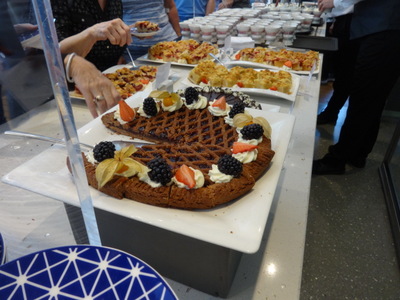
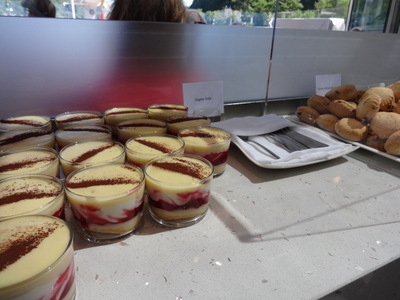 The second event of the afternoon, at 3:30 p.m., was German Teatime, which had been set up on the enclosed part of the terrace while we were watching castles. Unfortunately, no actual tea was involved, unless you wanted to fetch your own from the coffee station downstairs.
The second event of the afternoon, at 3:30 p.m., was German Teatime, which had been set up on the enclosed part of the terrace while we were watching castles. Unfortunately, no actual tea was involved, unless you wanted to fetch your own from the coffee station downstairs.
At the left here is Linzertorte, with plum cake and apple cake in the background.
At the right are individual English trifles (scones to the right of them).

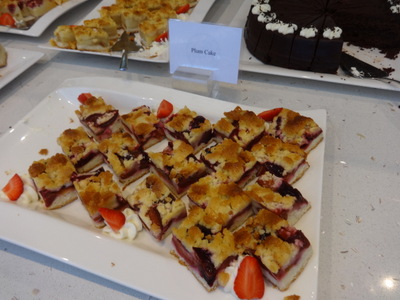 At the left here is is Sachertorte (invented at the Hotel Sacher in Vienna).
At the left here is is Sachertorte (invented at the Hotel Sacher in Vienna).
At the right, plum cake (a layer of cake batter with a layer of fresh plums and a layer of streusel topping applied, then baked.
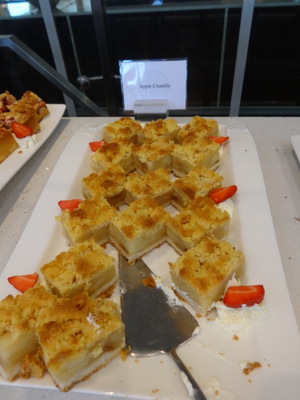
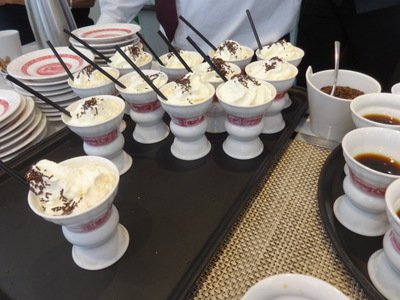 At the left, apple crumble. I don't show the strawberry-rhubarb crumble, because it looks just like the plum cake.
At the left, apple crumble. I don't show the strawberry-rhubarb crumble, because it looks just like the plum cake.
At the right, coffee, in special cups. You could have it plain, black, or they would put whipped cream or ice cream in it for you. And sprinkle it with chocolate shot.
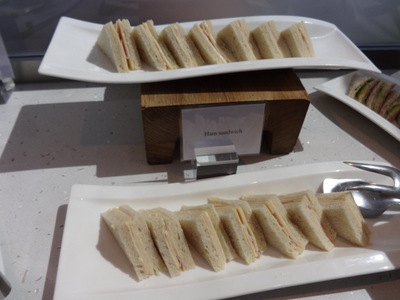
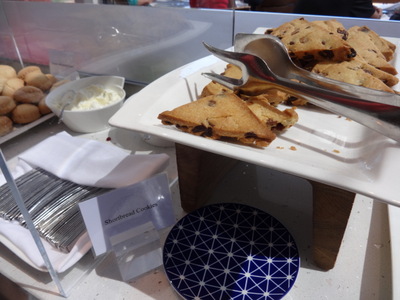 At the right, finger sandwiches. These are ham and cheese, but there were also cucumber, egg salad, and smoked salmon.
At the right, finger sandwiches. These are ham and cheese, but there were also cucumber, egg salad, and smoked salmon.
For my money, the triangular chocolate-chip shortbread cookies at the right were the best item on offer. They were great!
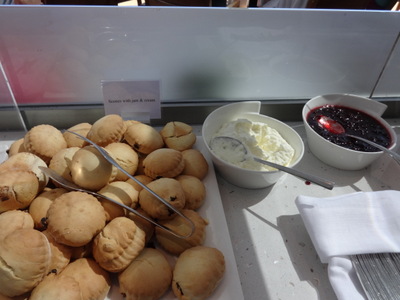
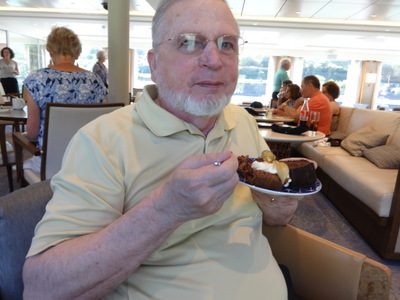 Here are the scones, with whipped cream and jam. They didn't look auspicious to me.
Here are the scones, with whipped cream and jam. They didn't look auspicious to me.
And here is David, very uncharacteristically chowing down on sweets between meals. And enjoying it thoroughly. He's got both Linzertorte and Sachertorte on that plate.
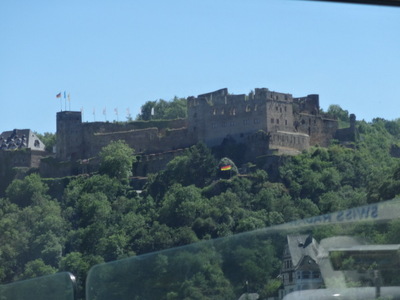
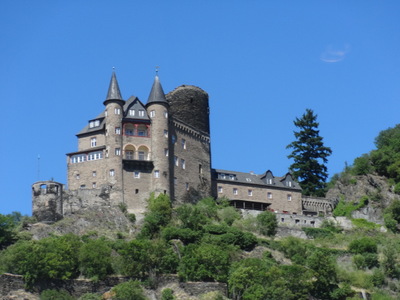 More castles. From my notes above, I think the one on the right may be Cat.
More castles. From my notes above, I think the one on the right may be Cat.
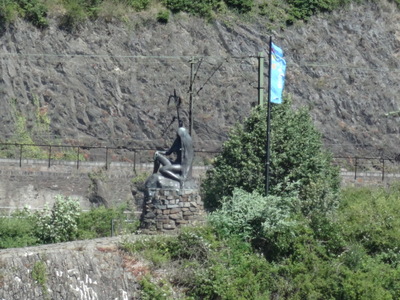
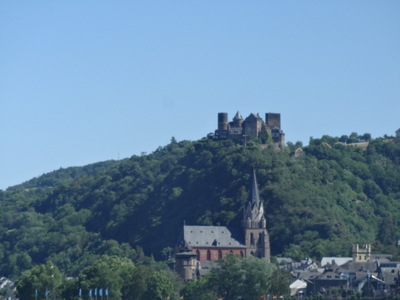 Here, at the left, tucked in among the castles is the famous Lorelei Rock, on which many sailors have come to grief, lured by the ghostly song of a mythical maiden. (The mountain behind it and a small waterfall apparently generated a confusing murmuring echo, now hard to hear because of urbanization of the area.) The rock itself used to be just a little spit of land sticking out into the river, but apparently a few years ago a passing lady tourist said, "That's it?! That little thing?," and proceeded to give money to have this statue of the Lorelei maiden (strongly telephotoed in my shot) mounted on it to make it more presentable.
Here, at the left, tucked in among the castles is the famous Lorelei Rock, on which many sailors have come to grief, lured by the ghostly song of a mythical maiden. (The mountain behind it and a small waterfall apparently generated a confusing murmuring echo, now hard to hear because of urbanization of the area.) The rock itself used to be just a little spit of land sticking out into the river, but apparently a few years ago a passing lady tourist said, "That's it?! That little thing?," and proceeded to give money to have this statue of the Lorelei maiden (strongly telephotoed in my shot) mounted on it to make it more presentable.
At the right, another castle.
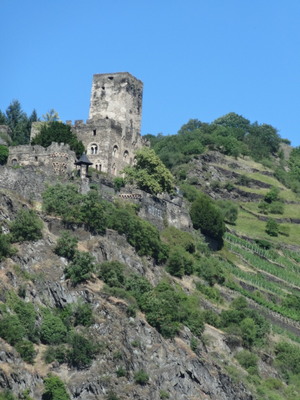
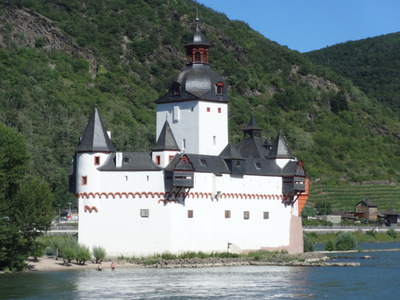 Left, another castle up on the hills.
Left, another castle up on the hills.
Right, a castle that stood out from others in being (a) white and (b) right down on the river's edge rather than on high, defensible ground. I suspect it's much more recent that the others and never had to serve as a military stronghold.

 Two events (besides dinner) were also scheduled for the evening. The first was the Viking Explorers' Society cocktail party, which featured free drinks and passed hors d'oeuvres. A VES member is anyone who's ever been on a Viking cruise before, so we qualify, but I don't benefit from the free drinks because the orange juice is always free. Routinely on a Viking cruise, all soft drinks and wine and beer served with dinner are free, but hard liquor and wines other than the "house" red and white cost extra. (Viking heavily advertises its "Silver Spirits Package, the option to pay a flat fee up front and enjoy completely open bar for the whole cruise—definitely not worth the money for us.) But the VES party is always open bar, so David had a glass of champagne.
Two events (besides dinner) were also scheduled for the evening. The first was the Viking Explorers' Society cocktail party, which featured free drinks and passed hors d'oeuvres. A VES member is anyone who's ever been on a Viking cruise before, so we qualify, but I don't benefit from the free drinks because the orange juice is always free. Routinely on a Viking cruise, all soft drinks and wine and beer served with dinner are free, but hard liquor and wines other than the "house" red and white cost extra. (Viking heavily advertises its "Silver Spirits Package, the option to pay a flat fee up front and enjoy completely open bar for the whole cruise—definitely not worth the money for us.) But the VES party is always open bar, so David had a glass of champagne.
The hors d'oeuvres were good, though. I think the little tartlets were olive tapenade, and the chopped pink was raw fish on black bread. The spherical things were falafel resting in dabs of hummus.

 Two final castles, one free standing and the other imprisoned behind a modern port authority building.
Two final castles, one free standing and the other imprisoned behind a modern port authority building.
Keep in mind that the castles I show here are by no means all that we saw—they're just the ones of which I got half-way decent pictures. The landscape is truly littered with castles.
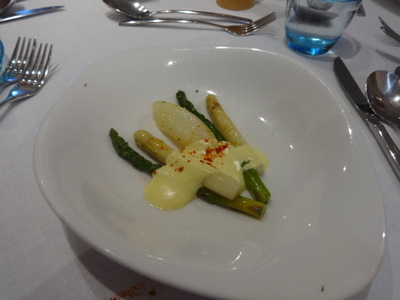
 The dinner menu was hopeless. The starter choices were a "meli-melo" chopped salad (I stopped reading when I got to avocado, which I'm allergic to) and New England Clam Chowder, described as "fish velouté with clams, i.e., flour-thickened fish stock with clams. Nope. Too American and not even authentically so! The lady next to me ordered it and said it was mostly velouté; the clam bits were hard to find, and there was nothing else in it.
The dinner menu was hopeless. The starter choices were a "meli-melo" chopped salad (I stopped reading when I got to avocado, which I'm allergic to) and New England Clam Chowder, described as "fish velouté with clams, i.e., flour-thickened fish stock with clams. Nope. Too American and not even authentically so! The lady next to me ordered it and said it was mostly velouté; the clam bits were hard to find, and there was nothing else in it.
The main course choices were prawn curry (I like prawn curry, but not from this kitchen) and vegetarian spinach and ricotta Cannelloni. Dessert was lime cake.
So I ordered all three regional specialities, which for once were actually specialties of the region where we found ourselves. At the left, "fresh seasonal asparagus [green and white], boiled spring potatoes, and [not half bad] sauce Hollandaise." Very good.
At the right is "Krustenbraten," described as crispy roast pork, beer sauce, creamy savoy cabbage." That was really good. The roast pork itself was moist and tender and not a bit crispy, but it was topped with a square of tender, flavorful, shatteringly crisp roasted pork skin. Excellent. The cabbage was good, too.
 The dessert was "Donauwelle, Germany cherry chocolate cake, wheat crumble." Okay, but not as good as it sounded. I don't know whether the chef had a set of molds in his wavy shape or, more likely, a cutter of that shape with which he subdivided sheets of dessert—many of the desserts were shaped like this. This one was a layer of chocolate cake topped by a thick layer of white Bavarian cream wth a red (presumably cherry) glaze on top.
The dessert was "Donauwelle, Germany cherry chocolate cake, wheat crumble." Okay, but not as good as it sounded. I don't know whether the chef had a set of molds in his wavy shape or, more likely, a cutter of that shape with which he subdivided sheets of dessert—many of the desserts were shaped like this. This one was a layer of chocolate cake topped by a thick layer of white Bavarian cream wth a red (presumably cherry) glaze on top.
The "wheat crumble" was the granola-like bits scattered on the plate.
The evening's second event was a performance buy the "Upside Down Duo," a female vocalist and a male pianist. No idea why the name, except that she had quite a low voice, and when he chimed in on harmony, it was often in a high falsetto.
They were billed as delivering "a delightful mix of swinging jazz tunes from various decades," but what they did was start with the 1930s and step systematically forward in time, doing one song for each decade up to the present.
- 1930s: The Sunny Side of the Street
- 1940s: I've Got You under My Skin
- 1950s: Come Fly with Me
- 1960s: The Girl from Ipanema
- 1970s: Stayin' Alive
- 1980s: Stevie Wonder's Overjoyed
- 1990s: Skipped, because "there wasn't anything"
- 2000s: Amy Winehouse's Rehab
I knew the first five, but they lost me about 1980. They also taught us the German word for "encore," which is "zugabbe."
I went to bed after that, but those who wanted could stay on for more music and dancing with Ivan at the piano.
Previous entry
List of Entries
Next entry

 We just stayed in Winningen overnight—David and I never left the ship. At 6 a.m. on Thursday, we cast off again, headed for Koblenz, which is at the confluence of the Moselle and the Rhine. By this time, I had dicovered that another channel on our stateroom TVs continuously showed the view of the bow camera! What a terrific idea. I turned it on Thursday morning as I was getting dressed to go to breakfast and found that we were entering a lock. The photo at the left is taken off the TV screen. We were traveling downstream on the Moselle, so of course we entered each lock high up, then sank to the level of the next stretch of river.
We just stayed in Winningen overnight—David and I never left the ship. At 6 a.m. on Thursday, we cast off again, headed for Koblenz, which is at the confluence of the Moselle and the Rhine. By this time, I had dicovered that another channel on our stateroom TVs continuously showed the view of the bow camera! What a terrific idea. I turned it on Thursday morning as I was getting dressed to go to breakfast and found that we were entering a lock. The photo at the left is taken off the TV screen. We were traveling downstream on the Moselle, so of course we entered each lock high up, then sank to the level of the next stretch of river.
 At Koblenz, the Moselle flows into the Rhine at an acute angle. We came down the Moselle, made a sharp turn to the right, cruised upstream on the Rhine for a couple of hundred yards, and moored. Another Viking ship, the Skirnir, was already there, so we moored outboard of it and had to walk through its lobby to disembark. As the lettering on their sterns shows, both are registered in Basel (Switzerland). If the last four digits of their numbers are dates, then the Skirnir is considerably newer.
At Koblenz, the Moselle flows into the Rhine at an acute angle. We came down the Moselle, made a sharp turn to the right, cruised upstream on the Rhine for a couple of hundred yards, and moored. Another Viking ship, the Skirnir, was already there, so we moored outboard of it and had to walk through its lobby to disembark. As the lettering on their sterns shows, both are registered in Basel (Switzerland). If the last four digits of their numbers are dates, then the Skirnir is considerably newer.
 Like the castle in Cochem, Koblenz was thickly encumbered with festival tents. When we came ashore on this riverside walk, I asked if a market were about to open, but no, all the tents that line the walk (and many other areas around town) are a propos of an upcoming footrace.
Like the castle in Cochem, Koblenz was thickly encumbered with festival tents. When we came ashore on this riverside walk, I asked if a market were about to open, but no, all the tents that line the walk (and many other areas around town) are a propos of an upcoming footrace.
 Across the river, on the top of the bluff is the Ehrenbreitstein Fortress. The site has been fortified since the 9th century, but the fortifications were continually modified and rebuilt for centuries, right up into the 19th century. It's yet another edifice that Louis XIV took, then abandoned and destroyed (in this case, blew up), but it took the French troops five sieges and 10 years to take it. (I'm betting it was Vauban who finally figured out how to beat it.) After WWII it was supposed to be destroyed again, but Henry T. Allen, chief allied commander of this area after the war, countermanded those orders. It now houses several museums and performance venues.
Across the river, on the top of the bluff is the Ehrenbreitstein Fortress. The site has been fortified since the 9th century, but the fortifications were continually modified and rebuilt for centuries, right up into the 19th century. It's yet another edifice that Louis XIV took, then abandoned and destroyed (in this case, blew up), but it took the French troops five sieges and 10 years to take it. (I'm betting it was Vauban who finally figured out how to beat it.) After WWII it was supposed to be destroyed again, but Henry T. Allen, chief allied commander of this area after the war, countermanded those orders. It now houses several museums and performance venues.
 Koblenz had great ornamental plantings. At the left here are short-stalked daylilies, and at the right foxgloves and maybe astilbe?
Koblenz had great ornamental plantings. At the left here are short-stalked daylilies, and at the right foxgloves and maybe astilbe?
 This huge fig tree was on the grounds of the Basilica of St. Kastor. The large figs weren't ripe yet. The wild cucumber at the right probably wasn't supposed to be part of the plantings, but I sort of like wild cucumbers, even as weeds.
This huge fig tree was on the grounds of the Basilica of St. Kastor. The large figs weren't ripe yet. The wild cucumber at the right probably wasn't supposed to be part of the plantings, but I sort of like wild cucumbers, even as weeds.
 On the way to St. Kastor's, we passed the Ludvig Museum of modern art. Ludvig was a rich industrialist who donated the house and collection.
On the way to St. Kastor's, we passed the Ludvig Museum of modern art. Ludvig was a rich industrialist who donated the house and collection. 
 Here (left) is a statue commemorating Koblenz native Johannes Peter Müller, 19th century physician, physiologist, and natural historian.
Here (left) is a statue commemorating Koblenz native Johannes Peter Müller, 19th century physician, physiologist, and natural historian.
 The guide pointed out many historic buildings as we went. A dark-red house in the middle of town he said had been the home of the groers' guilde. Another was built by a rich and noble family that had produced an Archbishop of Mainz. Both are now privately owned. One church, with an elegant white tower, was dedicated to St. Florin, a major patron saint of wine makers. The French used it as a storehouse and then as a slaughterhouse, but it was eventually given to the local protestants, who continue to use it today.
The guide pointed out many historic buildings as we went. A dark-red house in the middle of town he said had been the home of the groers' guilde. Another was built by a rich and noble family that had produced an Archbishop of Mainz. Both are now privately owned. One church, with an elegant white tower, was dedicated to St. Florin, a major patron saint of wine makers. The French used it as a storehouse and then as a slaughterhouse, but it was eventually given to the local protestants, who continue to use it today.
 The only church we actually went inside was the Catholic Liebfrauenkirche, shown at the left. At the right is a view down the nave.
The only church we actually went inside was the Catholic Liebfrauenkirche, shown at the left. At the right is a view down the nave. 
 At the left here is the view back the other way along the nave, showing some of the pipes of the organ.
At the left here is the view back the other way along the nave, showing some of the pipes of the organ.
 In a smaller courtyard, the guide showed us this fountain, a famous landmark of Koblenz. After the French occupation of 1794–1814, Koblenz found itself with a whole generation of children born to French fathers and unwed mothers. The mothers had to work, and no father figures were around, so the boys, in particular ran unsupervised and wild. These boys were derisively called "Jean," prototypically French, but it was corrupted to "schang" and than "schängel." The word is still used affectionately today for a small child, meaning something like "brat" or "kid."
In a smaller courtyard, the guide showed us this fountain, a famous landmark of Koblenz. After the French occupation of 1794–1814, Koblenz found itself with a whole generation of children born to French fathers and unwed mothers. The mothers had to work, and no father figures were around, so the boys, in particular ran unsupervised and wild. These boys were derisively called "Jean," prototypically French, but it was corrupted to "schang" and than "schängel." The word is still used affectionately today for a small child, meaning something like "brat" or "kid." 
 In the square with the rolling eyes and red tongue was this terrific history column. The guide didn't have time to stop and interpret it for us, but its wonderfully intricate and depicts the town's history, from a boat-load of rowers at the bottom to a selection of the town's most recognizable steeples at the top.
In the square with the rolling eyes and red tongue was this terrific history column. The guide didn't have time to stop and interpret it for us, but its wonderfully intricate and depicts the town's history, from a boat-load of rowers at the bottom to a selection of the town's most recognizable steeples at the top.
 In housewares stores we passed, I spotted these wonderful round cushions, made to depict slices of watermelons and oranges. There were also grapefruit and limes, but they were all the same size as the watermelon slices.
In housewares stores we passed, I spotted these wonderful round cushions, made to depict slices of watermelons and oranges. There were also grapefruit and limes, but they were all the same size as the watermelon slices.

 At the end of the walking tour, our guide took us back to the river bank a ways upstream of the ship and pointed out our mooring to us. David wanted to go back to rest his feet before lunch, but since we arrived, I had been eyeing the magnificent cablecar, whose bottom terminal was just yards from the ship (you can see part of its cable in the photo of the Ehrenbreitstein Fortress, above). I love cablecars; David hates 'em.
At the end of the walking tour, our guide took us back to the river bank a ways upstream of the ship and pointed out our mooring to us. David wanted to go back to rest his feet before lunch, but since we arrived, I had been eyeing the magnificent cablecar, whose bottom terminal was just yards from the ship (you can see part of its cable in the photo of the Ehrenbreitstein Fortress, above). I love cablecars; David hates 'em.
 Here are a couple of views from the car, one of a car headed the other way and one looking back toward the town. In the latter, you get a very good view of the Deutsches Eck (with its 16 flags around the edge) and at least the massive pedestal of William I. The statue itself is hard to make out against the dark background.
Here are a couple of views from the car, one of a car headed the other way and one looking back toward the town. In the latter, you get a very good view of the Deutsches Eck (with its 16 flags around the edge) and at least the massive pedestal of William I. The statue itself is hard to make out against the dark background.
 At the top, we were warned to keep our tickets for the return trip. The dotted lines arriving from the top on the green map indicate the cablecar (the ones arriving from the bottom left indicate a funicular, and a road actually seems to come in from the lower right). We therefore found ourselves a good hike from the actual museum buildings, on a vast expanse of open, flat grassland with sidewalks. It was broiling hot up there, and I didn't have a lot of time (we had to be back on board not just for lunch but because at 12:30, the boat was setting sail again), so I just walked around the area near the cablecar terminal photographing this map and the one at the right (a relief map labeled in Braille for the blind), checking out the menu at the snack-bar/coffee shop, reading the posters for upcoming plays and concerts (and a bird-of-prey show), and then got back on the cablecar to go back down. It was the ride I came for, anyway.
At the top, we were warned to keep our tickets for the return trip. The dotted lines arriving from the top on the green map indicate the cablecar (the ones arriving from the bottom left indicate a funicular, and a road actually seems to come in from the lower right). We therefore found ourselves a good hike from the actual museum buildings, on a vast expanse of open, flat grassland with sidewalks. It was broiling hot up there, and I didn't have a lot of time (we had to be back on board not just for lunch but because at 12:30, the boat was setting sail again), so I just walked around the area near the cablecar terminal photographing this map and the one at the right (a relief map labeled in Braille for the blind), checking out the menu at the snack-bar/coffee shop, reading the posters for upcoming plays and concerts (and a bird-of-prey show), and then got back on the cablecar to go back down. It was the ride I came for, anyway.
 The view at the left here shows the distinctly different colors of the waters of the two rivers where they flow together. The boundary between them persisted for quite a ways downstream.
The view at the left here shows the distinctly different colors of the waters of the two rivers where they flow together. The boundary between them persisted for quite a ways downstream.
 Once again, all the "regional specialties" at lunch were Italian, starting with roasted veggie salad from the salad bar, then coppa and ricotta crostini, and culminating with spaghetti and meatballs from the pasta station.
Once again, all the "regional specialties" at lunch were Italian, starting with roasted veggie salad from the salad bar, then coppa and ricotta crostini, and culminating with spaghetti and meatballs from the pasta station.
 David had the "navarin printanier" (spring stew) of lamb, and I went to the pasta station for just a small portion of the spaghetti and meatballs, which David had had some other day and said was good—he was right.
David had the "navarin printanier" (spring stew) of lamb, and I went to the pasta station for just a small portion of the spaghetti and meatballs, which David had had some other day and said was good—he was right.
 As promised, the ship cast off and headed upstream while we ate lunch, headed for Mainz. Two events were on the agenda. We were passing through the prime ruined-castle country of the middle Rhine, so starting at 2:00 p.m., Devin would narrate, naming the castles and explaining their influence on literature and art. Apparently the whole Romantic movement is the result of tourism in this area. It was popular with vacationers even in the 18th and 19th centuries—Percy Bysse and Mary Shelley were here, and Lord Byron, and all the rest. Mark Twain wrote about it in A Tramp Abroad. Wagner was the court composer of Bavarian but the Song of the Niebelungen/ring cycle was written about the Rhine valley.
As promised, the ship cast off and headed upstream while we ate lunch, headed for Mainz. Two events were on the agenda. We were passing through the prime ruined-castle country of the middle Rhine, so starting at 2:00 p.m., Devin would narrate, naming the castles and explaining their influence on literature and art. Apparently the whole Romantic movement is the result of tourism in this area. It was popular with vacationers even in the 18th and 19th centuries—Percy Bysse and Mary Shelley were here, and Lord Byron, and all the rest. Mark Twain wrote about it in A Tramp Abroad. Wagner was the court composer of Bavarian but the Song of the Niebelungen/ring cycle was written about the Rhine valley.
 Devin even claimed that a bunch of them were sitting around making up scary stories on one such trip, and when Mary Shelly's turn came she won the competition hands down and stood all their hair on end with the original form of her Frankenstein story.
Devin even claimed that a bunch of them were sitting around making up scary stories on one such trip, and when Mary Shelly's turn came she won the competition hands down and stood all their hair on end with the original form of her Frankenstein story.
 More castles, and I saw some herring gulls over the river. At one point, we passed the Viking Hild headed the other way.
More castles, and I saw some herring gulls over the river. At one point, we passed the Viking Hild headed the other way.

 The second event of the afternoon, at 3:30 p.m., was German Teatime, which had been set up on the enclosed part of the terrace while we were watching castles. Unfortunately, no actual tea was involved, unless you wanted to fetch your own from the coffee station downstairs.
The second event of the afternoon, at 3:30 p.m., was German Teatime, which had been set up on the enclosed part of the terrace while we were watching castles. Unfortunately, no actual tea was involved, unless you wanted to fetch your own from the coffee station downstairs.
 At the left here is is Sachertorte (invented at the Hotel Sacher in Vienna).
At the left here is is Sachertorte (invented at the Hotel Sacher in Vienna).
 At the left, apple crumble. I don't show the strawberry-rhubarb crumble, because it looks just like the plum cake.
At the left, apple crumble. I don't show the strawberry-rhubarb crumble, because it looks just like the plum cake.
 At the right, finger sandwiches. These are ham and cheese, but there were also cucumber, egg salad, and smoked salmon.
At the right, finger sandwiches. These are ham and cheese, but there were also cucumber, egg salad, and smoked salmon.
 Here are the scones, with whipped cream and jam. They didn't look auspicious to me.
Here are the scones, with whipped cream and jam. They didn't look auspicious to me.
 More castles. From my notes above, I think the one on the right may be Cat.
More castles. From my notes above, I think the one on the right may be Cat.
 Here, at the left, tucked in among the castles is the famous Lorelei Rock, on which many sailors have come to grief, lured by the ghostly song of a mythical maiden. (The mountain behind it and a small waterfall apparently generated a confusing murmuring echo, now hard to hear because of urbanization of the area.) The rock itself used to be just a little spit of land sticking out into the river, but apparently a few years ago a passing lady tourist said, "That's it?! That little thing?," and proceeded to give money to have this statue of the Lorelei maiden (strongly telephotoed in my shot) mounted on it to make it more presentable.
Here, at the left, tucked in among the castles is the famous Lorelei Rock, on which many sailors have come to grief, lured by the ghostly song of a mythical maiden. (The mountain behind it and a small waterfall apparently generated a confusing murmuring echo, now hard to hear because of urbanization of the area.) The rock itself used to be just a little spit of land sticking out into the river, but apparently a few years ago a passing lady tourist said, "That's it?! That little thing?," and proceeded to give money to have this statue of the Lorelei maiden (strongly telephotoed in my shot) mounted on it to make it more presentable.
 Left, another castle up on the hills.
Left, another castle up on the hills.
 Two events (besides dinner) were also scheduled for the evening. The first was the Viking Explorers' Society cocktail party, which featured free drinks and passed hors d'oeuvres. A VES member is anyone who's ever been on a Viking cruise before, so we qualify, but I don't benefit from the free drinks because the orange juice is always free. Routinely on a Viking cruise, all soft drinks and wine and beer served with dinner are free, but hard liquor and wines other than the "house" red and white cost extra. (Viking heavily advertises its "Silver Spirits Package, the option to pay a flat fee up front and enjoy completely open bar for the whole cruise—definitely not worth the money for us.) But the VES party is always open bar, so David had a glass of champagne.
Two events (besides dinner) were also scheduled for the evening. The first was the Viking Explorers' Society cocktail party, which featured free drinks and passed hors d'oeuvres. A VES member is anyone who's ever been on a Viking cruise before, so we qualify, but I don't benefit from the free drinks because the orange juice is always free. Routinely on a Viking cruise, all soft drinks and wine and beer served with dinner are free, but hard liquor and wines other than the "house" red and white cost extra. (Viking heavily advertises its "Silver Spirits Package, the option to pay a flat fee up front and enjoy completely open bar for the whole cruise—definitely not worth the money for us.) But the VES party is always open bar, so David had a glass of champagne.
 Two final castles, one free standing and the other imprisoned behind a modern port authority building.
Two final castles, one free standing and the other imprisoned behind a modern port authority building.
 The dinner menu was hopeless. The starter choices were a "meli-melo" chopped salad (I stopped reading when I got to avocado, which I'm allergic to) and New England Clam Chowder, described as "fish velouté with clams, i.e., flour-thickened fish stock with clams. Nope. Too American and not even authentically so! The lady next to me ordered it and said it was mostly velouté; the clam bits were hard to find, and there was nothing else in it.
The dinner menu was hopeless. The starter choices were a "meli-melo" chopped salad (I stopped reading when I got to avocado, which I'm allergic to) and New England Clam Chowder, described as "fish velouté with clams, i.e., flour-thickened fish stock with clams. Nope. Too American and not even authentically so! The lady next to me ordered it and said it was mostly velouté; the clam bits were hard to find, and there was nothing else in it. The dessert was "Donauwelle, Germany cherry chocolate cake, wheat crumble." Okay, but not as good as it sounded. I don't know whether the chef had a set of molds in his wavy shape or, more likely, a cutter of that shape with which he subdivided sheets of dessert—many of the desserts were shaped like this. This one was a layer of chocolate cake topped by a thick layer of white Bavarian cream wth a red (presumably cherry) glaze on top.
The dessert was "Donauwelle, Germany cherry chocolate cake, wheat crumble." Okay, but not as good as it sounded. I don't know whether the chef had a set of molds in his wavy shape or, more likely, a cutter of that shape with which he subdivided sheets of dessert—many of the desserts were shaped like this. This one was a layer of chocolate cake topped by a thick layer of white Bavarian cream wth a red (presumably cherry) glaze on top.